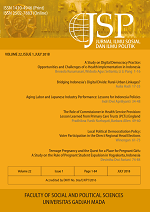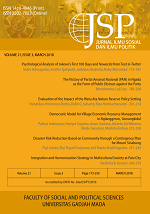Poverty and Digital Divide: A Study in Urban Poor Neighborhoods
Tri Mulyaningsih(1*), Rutiana Wahyunengseh(2), Sri Hastjarjo(3)
(1) Department of Economics, FEB Universitas Sebelas Maret, Indonesia
(2) Department of Public Administration, FISIP, Universitas Sebelas Maret, Indonesia
(3) Department of Communication, FISIP, Universitas Sebelas Maret, Indonesia
(*) Corresponding Author
Abstract
Literature suggests that the penetration of digital technology may create a digital divide, particularly for groups that lack resources and the capacity to access technology. This study is keen to examine the poverty and digital divide, particularly in urban poor areas. There are two research objectives. Firstly, to examine the digital diffusion and digital literacy within poor urban neighborhoods in the City of Magelang, Central Java, Indonesia. Secondly, to understand the variation of digital diffusion and digital literacy across areas (with different levels of poverty), age groups, genders and occupations. The data is collected from surveys focused on measuring the access to information, digital diffusion and the use of technology among the poor. This study found that there is a digital divide problem among people in urban areas, especially among people with low incomes. Moreover, the diffusion is dominated by certain groups such as younger people and females. Furthermore, digital literacy among the poor is low. The policy implication is to improve access for digital diffusion and provide assistance to improve digital literacy skills.
Keywords
Full Text:
PDFReferences
Avgerou, Chrisanthi. (2010). Discourses on ICT and development. Information Technologies and International Development, 6, 1–18.
Badan Pusat Statistik. (2020). Persentase penduduk mis kin me n u r ut pr ovin s i . Persent ase Penduduk Miskin Menurut Provinsi.
Broady, T., Chan, A., & Caputi, P. (2010). Comparison of older and younger adults’ attitudes towards and abilities with computers: Implications for training and learning. British Journal of Educational Technology, 41(3), 473–485. https://doi. org/10.1111/j.1467-8535.2008.00914.x
Buckingham, D. (2006). Defining digital literacy What do young people need to know about digital media? Digital Kompetanse, 1(4), 263–276.
Chen M.A. (2016). Technology, informal w o rkers a nd c itie s : i ns igh ts f ro m Ahmedabad (India), Durban (South Africa) and Lima (Peru). Environment and Urbanization, 28(2), 405–422. https://doi. org/10.1177/0956247816655986
Chen, W., & Wellman, B. (2005). Minding the cyber-gap: The Internet and social inequality. In M. Romero & E. Margolis (Eds.), The Blackwell companion to social inequalities (pp. 523–545). Blackwell.
Chinn, M. D., & Fairlie, R. W. (2007). The determinants of the global digital divide: A cross-country analysis of computer and inter net pene tr ati o n. O xf o rd Economic Papers, 59(1), 16–44. https://doi. org/10.1093/oep/gpl024
Ciborra, C. U. (2009). Interpreting E-gov ernment and Dev elopment: Efficiency, Transparency or Governance at a Distance? In Bricolage, Care and Information. Palgrave Macmillan UK. https://doi.org/10.1057/9780230250611_5
DiMaggio, P., & Hargittai, E. (2001). From the ‘Digital Divide’ to `Digital Inequality’: Studying Internet Use as Penetration Increase.
Flor, A. G. (2014). ICT and Poverty: The Indisputable Link. https://www.researchgate.net/publication/246409174
Goslee, S., & Conte, C. (1998). Losing ground bit by bit: Low-income communities in the information age.
Hale, T. M., Cotten, S. R., Drentea, P., & Goldner, M. (2010). Rural-Urban Differences in General and Health- Related Internet Use. American Behavioral Scientist, 53(9), 1304–1325. https://doi. org/10.1177/0002764210361685
Hargittai, E., & Hinnant, A. (2008). Digital Inequality. Communication Research, 35(5), 602–621. https://doi. org/10.1177/0093650208321782
Hoffman, D. L. , & Novak, T. P. (1998). The Evolution of the Digital Divide: Examining the Relationship of Race to Internet Access and Usage Over Time.
Horrigan, J. (2000). New internet users: What they do on-line, what they don’t, and Implications for the `Net’s’ Future.
Howard, P. N., Busch, L., & Sheets, P. (2010). Comparing Digital Divides: Internet Access and Social Inequality in Canada and the United States. Canadian Journal of Communication, 35(1), 109–128. https://doi. org/10.22230/cjc.2010v35n1a2192
Hymes, D. (1974). Foundations in socioliguistics; An ethnographic approach. University of Pennsylvania Press.
Kling, R. (1996). Computerization and Controversy: Value Conflicts and Social Choices. Academic Press.
Livingstone, S., Bober, M., & Helsper, E. (2005). Internet literacy among children and young people.
Madden, M. (2006). Internet penetration and impact. Pew Internet and American Life Project.
Mann, C. L. (2003). Information Technologies and International Development: Conceptual Clarity in the Search for Commonality and Diversity. International Technologies & International Development, 1(2), 67–79.
Mitlin, D. (2004). Understanding Urban Poverty – What the Poverty Reduction Strategy Papers tell u.
OECD. (2001). Understanding the digital divide.
Ono, H., & Zavo d ny, M . (2007). D igital inequality: A five country comparison using microdata. Social Science Research, 36(3), 1135–1155. https://doi.org/10.1016/j.ssresearch.2006.09.001
Quibria, M. G., Ahmed, S. N., Tschang, T., & Reyes-Macasaquit, M.-L. (2003). Digital divide: determinants and policies with special reference to Asia. Journal of Asian Economics, 13(6), 811–825. https://doi. org/10.1016/S1049-0078(02)00186-0
Rasi, P., Vuojärvi, H., & Rivinen, S. (2021). Promoting Media Literacy Among Older People: A Systematic Review. Adult Education Quarterly, 71(1), 37–54. https:// doi.org/10.1177/0741713620923755
Sahay, S. (2001). Introduction to the special issue on "IT and Health Care in Developing Countries. Electronic Journal on Information Systems in Developing Countries, 5(0), 1–6.
Schreurs, K., Quan-Haase, A., & Martin, K. (2017). Problematizing the Digital Literacy Paradox in the Context of Older Adults’ ICT Use: Aging, Media Discourse, and Self-Determination. Canadian Journal of Communication, 42(2), 359–377. https:// doi.org/10.22230/cjc.2017v42n2a3130
Sinha, S., & Lipton, M. (1999). Damaging fluctuations, risk and poverty: A Review.
Strover, S. (2001). Rural internet connectivity. Telecommunications Policy, 25(5), 331–347. https://doi.org/10.1016/S0308-5961(01)00008-8
United Nation Development Program. (2019). UNDP Indonesia Sustainable Urban Development Strategy.
U.S. Department of Commerce. (2002). A Nation online: How Americans are expanding their use of the internet.
van Dijk, J. A. G. M. (2006). Digital divide research, achievements and shortcomings. Poetics, 34(4–5), 221–235. https://doi. org/10.1016/j.poetic.2006.05.004
Wade, R. (2004). Bridging the digital divide: new route to development or new form of dependency? In C Avgerou, C. Ciborra, & F. Land (Eds.), The Social Study of Information and Communication Technology: Innovation, Actions, and Contexts (pp.185–206). Oxford University Press.
Walsham, G., Robey, D., & Sahay, S. (2007). Foreword: Special issue on information systems in developing countries. MIS Quarterly, 317–326.
Wilson, E. (2000). Closing the digital divide: An initial review. Briefing the President.
World Bank. (2016). World Development Report 2016: Digital Dividends.
Article Metrics
Refbacks
- There are currently no refbacks.
Copyright (c) 2021 Jurnal Ilmu Sosial dan Ilmu Politik

This work is licensed under a Creative Commons Attribution-NonCommercial-NoDerivatives 4.0 International License.






















